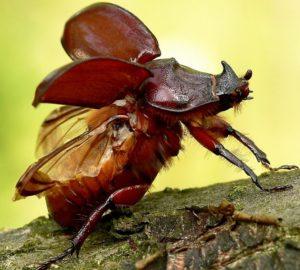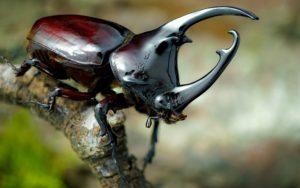Rhinoceros beetle larva and adult with a horn on its head
The Coleoptera order is considered the most diverse and occupies a leading position in terms of the number of species in the animal kingdom. According to official figures, this group of insects has about 390 thousand different beetles that currently live on the planet, and many of them are unique creatures.
Content
Rhinoceros beetles: photo
What is a rhinoceros beetle
Name: common rhinoceros beetle
Latin: Oryctes nasicornisClass: Insects - Insecta
Squad: Coleoptera - Coleoptera
Family: Lamellar - Scarabaeidae
 | Habitats: | everywhere in warm climates |
 | Dangerous for: | benefits, recycles leftovers |
 | Means of destruction: | don't need to be destroyed |
The rhinoceros beetle is one of the most recognizable members of the lamellar family. Representatives of this species are difficult to confuse with anyone, because they the main distinguishing feature is a long curved growth on the head, very reminiscent of the shape of a rhinoceros horn. It is thanks to this feature that insects of this species were called rhinoceros beetles.
Appearance and body structure of the rhinoceros beetle
| Body size and shape | The body of an adult rhinoceros beetle can reach a length of 2,5-4,5 cm. The color is dominated by brown tones and sometimes there is a reddish tint. The surface of the head, pronotum, and elytra are always distinguished by a characteristic sheen. The shape of the body is quite wide, and its upper side is convex. |
| Head | The head is small and shaped like a triangle. On the sides are antennae and eyes. The antennae consist of 10 segments and have a lamellar club at the ends, characteristic of their family. |
| beetle horn | In the center, in the nasal part of the head, there is a long curved horn. This part of the body is well developed only in males. At the same time, they do not use it as a weapon for protection or fights during the mating season, and the purpose of such a bright organ remains unknown. As for females, only a small tubercle appears in place of the horn. |
| Wings | The rhinoceros beetle has well-developed wings and despite its heavy body, these insects can fly very well. In the course of a scientific experiment, it was proved that they are able to make continuous flights over a distance of up to 50 km. At the same time, scientists are convinced that, given the structure of their body and all existing laws of aerodynamics, rhinoceros beetles should not fly. |
| Feet | The limbs of the rhinoceros beetle are powerful. The front pair of legs is designed for digging and therefore are equipped with wide, flat lower legs, and characteristic teeth along the outer edge. The tibiae of the middle and posterior pair are also slightly widened and have teeth. On the paws of all three pairs of limbs, there are long and strong claws. |
Rhinoceros beetle larva
The newborn larva of the rhinoceros beetle reaches a length of only 2-3 cm, but thanks to active nutrition, it grows to an impressive size within a few years. At the time of pupation, the length of her body can already reach 8-11 cm.
Rhinoceros beetle lifestyle
Adults of the rhinoceros beetle do not live very long - from 2 to 4 months. In different weather conditions, their flight occurs at the end of spring, or in the middle of summer.
The main task of the imago is to leave behind offspring.
Some scientists argue that insects at this stage do not feed, but only use the reserves accumulated in the larval stage.
Beetles are active at dusk and at night. Sometimes, "rhinos", like other nocturnal insects, fly to sources of bright light. During the day, the beetles usually hide in hollow trees or the topsoil.
Shortly after mating and laying eggs, adult rhinoceros beetles die. Insects leave their egg-laying places near a suitable food source:
- rotten stumps;
- manure heaps;
- compost pits;
- sawdust;
- rotten tree trunks;
- hollow.
The diet of the larvae mainly includes the decaying remains of trees, shrubs and herbaceous plants. Sometimes they can switch to living roots, which is why they harm such crops:
- roses;
- peaches;
- grapes;
- apricots.
Distribution area
The range of rhinoceros beetles covers most of the eastern hemisphere. Representatives of this species can be found on the territory of such regions and countries:
- Central and Southern Europe;
- North Africa;
- Asia Minor and Central Asia;
- Northeast Turkey;
- Middle lane;
- Southern regions of Russia;
- Western Siberia;
- Southwestern regions of China and India;
- North of Kazakhstan.
For the life of beetles of this species, only the conditions of the British Isles, the northern regions of Russia, Iceland and the Scandinavian countries turned out to be unsuitable.
Habitat
Initially, the "rhinos" lived exclusively in broad-leaved forests, but due to the changes taking place in the world, they had to go beyond their usual terrain. At the moment, rhinoceros beetles can be found in some types of terrain and near people.
Comfortable places:
- windbreaks;
- steppes;
- semi-deserts;
- taiga.
Close to people:
- greenhouses;
- greenhouses;
- manure heaps;
- compost pits.
The value of the rhinoceros beetle in nature
Rhinoceros beetle larvae rarely feed on parts of living plants and do so only when no other food source is available. Therefore, they are not pests and their damage to cultivated plants is isolated cases. Science knows very little about the nutrition of adults, and therefore they are also not considered pests of crops or fruit trees.
Imago and larvae of the rhinoceros beetle occupy an important place in the food chain and included in the diet of many small predators, such as:
- birds;
- amphibians;
- small mammals;
- reptiles.
The larvae of this species also benefit by eating dead wood and other plant debris. Thus, they significantly speed up the process of their decomposition.
Conservation status of rhinoceros beetles
Representatives of this species are quite widespread and have even adapted to life outside their natural environment. But still their numbers are gradually decreasing and this is mainly due to human activities.
People annually cut down a huge number of trees and, first of all, old and diseased plants that begin to die are used. Because of this, the amount of rotten wood, which is the food base for the larvae of the rhinoceros beetle, decreases every year.
At the moment, rhinoceros beetles are protected in the following countries:
- Czech;
- Slovakia;
- Poland;
- Moldova.
In Russia, this type of beetle was even listed in the Red Books of such regions:
- Astrakhan region;
- Republic of Karelia;
- The Republic of Mordovia;
- Saratov region;
- Stavropol region;
- Vladimir region;
- Kaluga region;
- Kostroma region;
- Lipetsk region;
- The Republic of Dagestan;
- Chechen Republic;
- The Republic of Khakassia.
Interesting facts about rhinoceros beetles
Despite its wide distribution, this species is still poorly understood. There are several features of the rhinoceros beetle that amaze even scientists.
Rhinoceros beetles are large, massive insects and their wing size is too small for such a heavy body. Not a single modern law of aerodynamics can explain the mechanisms and principles by which these beetles fly.
Under the influence of ultraviolet rays, the elytra of rhinoceros beetles acquire semiconductor properties, and the hairs on its body can accumulate an electrostatic potential. If a flying rhinoceros beetle crashes into a person in the evening, the victim may feel a slight electric shock.
Most sources of information about rhinoceros beetles, for unknown reasons, have received the degree of "secret" and "for official use", so there is very little detailed information about representatives of this species in the public domain.
Conclusion
Rhinoceros beetles are unique creatures and many of their features, despite their vast habitat, still remain unexplored. The fact that the number of representatives of this species is gradually decreasing increases their importance even more, because rhinoceros beetles are not only an unsolved mystery of scientists, but also real orderlies of the forest.
Previous

